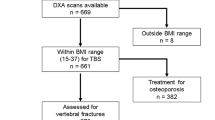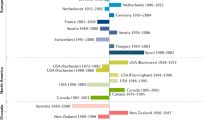Abstract
Measurement of bone mineral density (BMD) by dual-energy X-ray absorptiometry (DXA) is the recommended method for diagnosis of osteoporosis and assessment of future fracture risk. However, most patients who will suffer fractures do not have osteoporosis by DXA (T-score of −2.5 or less). Bone strength, which is most closely associated with resistance to fracture, is a composite of both bone density and bone quality, and the latter is not measured by DXA. Thus, other technology is needed for non-invasive and inexpensive assessment of bone strength and fracture risk. Vertebral fractures, the most common clinical fracture in the general population, are of even greater importance in rheumatoid arthritis and other rheumatic disorders. Vertebral fracture assessment (VFA) and trabecular bone scores (TBS), two techniques which can aid prediction of future fracture risk, can be used with currently available DXA machines. Description of these techniques and their potential application to clinical rheumatology practice will be the focus of this paper.
Similar content being viewed by others
References
Papers of particular interest, published recently, have been highlighted as: • Of importance •• Of major importance
NIH consensus development panel on osteoporosis prevention, diagnosis and therapy. Osteoporosis prevention diagnosis and therapy JAMA. 2001;285(6):785–96.
Kanis JA, Melton III LJ, Christiansen C, et al. The diagnosis of osteoporosis. J Bone Miner Res. 1994;9:1137–41.
Boutroy S, Bouxsein ML, Munoz F, et al. In vivo assessment of bone microstructure by high resolution peripheral computed tomography. J Clin Endocrinol Metab. 2005;90(12):6508–15.
Phan CM, Matsura M, Bauer JS, et al. Trabecular bone structure of the calcaneus: comparison of MR images at 3.0 and 1.5 T with micro-CT as the standard of reference. Radiology. 2006;488–96.
Lam SCB, Wald MJ, Rajapkse CS, et al. Performance of the MRI-Based virtual bone biopsy in the distal radius: serial reproducibility and reliability of structural and mechanical parameters in women representative of osteoporosis study populations. Bone. 2001;39(4):895–903.
Naylor KE, McClosky EV, Eastell R, et al. Use of DXA based finite element analysis of the proximal femur in a longitudinal study of hip fracture. J Bone Miner Res. 2013;28:1014–21.
Kanis JA, on behalf of the World Health Organization Scientific Group. Assessment of osteoporosis at the primary health-care level. Technical report. Geneva: World Health Organization; 2007.
Ross PD, Davis JW, Epstein RS, et al. Pre-existing fractures and bone mass predict vertebral fracture incidence in women. Arch Int Med. 1991;114:919–23.
Melton LJ, Atkinson EJ, Cooper C, et al. Vertebral fractures predict subsequent fractures. Osteoporos Int. 1999;10:214–21.
Cauley JA, Hochberg MC, Lui LY, et al. Long-term risk of incident vertebral fractures. JAMA. 2007;298(23):2761–8.
Ensrud KE, Thompson DE, Cauley JA, et al. Prevalent vertebral deformities predict mortality and hospitalization in older women with low bone mass. J Am Geriatr Soc. 2000;48:241–9.
Fink HA, Milavetz DL, Palermo L, et al. What proportion of incident radiographic vertebral deformities is clinically diagnosed and vice versa. J Bone Miner Res. 2005;20(7):1216–22.
Orstavik RE, Haugeberg G, Mowinckel P, et al. Vertebral deformities of rheumatoid arthritis: a comparison with population based controls. Arch Int Med. 2004;164:420–5.
Van Staa TP, Guesens P, Bijlsma JW, et al. Clinical assessment of long-term risk of fracture and patients with rheumatoid arthritis. Arthritis Rheum. 2006;54:3104–12.
de Nijs RNJ, Jacobs JWG, Bijlsma JWJ, et al. Prevalence of vertebral deformities and symptomatic vertebral fractures in corticosteroid treated patients with rheumatoid arthritis. Rheumatology. 2001;40:1375–83.
Orstavik RE, Haugeberg G, Uhlig T, et al. Incidence of vertebral deformities and 225 female rheumatoid arthritis patients measured by morphometric X-ray absorptiometry. Osteoporos Int. 2005;16:35–42.
Pell NF, Moore DJ, Barrington NA, et al. Risk of vertebral fracture and relation to bone mineral density in steroid treated patients with rheumatoid arthritis. Ann Rheum Dis. 1995;54:801–6.
Lodder MC, Haugeberg G, Lems WF, et al. Radiographic damage associated with low bone mineral density and vertebral deformities and rheumatoid arthritis. The Oslo-Trulo-Amsterdam (OSTRA) collaborative study. Arthritis Rheum. 2003;49:209–15.
Wright NC, Lisse JR, Wallit BT, et al. Arthritis increases the risk for fractures-results from the Women’s Health Initiative. J Rheumatol. 2011;38(8):1680–8.
Brennan SL, Toomey L, Kotowicz M, et al. Rheumatoid arthritis and incident fracture in women: a case–control study. BMC Musculoskelet Disord.
Vis M, Haavardsholm EA, Boyesen P, et al. High incidence of vertebral and non-vertebral fractures in the OSTRA cohort study: a 5 year follow-up study in postmenopausal women with rheumatoid arthritis. Osteoporos Int. 2011;22:2413–9.
Genant HK, Wu CY, van Kuijk C, Nevitt MC. Vertebral fracture assessment using a semiquantitative technique. J Bone Miner Res. 1993;8(9):1137–48.
Dirven L, van den Broek M, van Groenendael JHLM, et al. Prevalence of vertebral fractures in a disease activity steered cohort of patients with early active rheumatoid arthritis. BMC Musculoskelet Disord. 2012;13:125–32.
Damilakis J, Adams JE, Guglielmi G, Link TM. Radiation exposure in X-ray based imaging techniques used in osteoporosis. Eur Radiol. 2010;20(11):2707–14.
Lewiecki EM. Bone densitometry and vertebral fracture assessment. Curr Osteoporos Rep. 2010;8:123–30.
Greenspan SL, von Stetten E, Emond SK, et al. Instant vertebral assessment: a noninvasive dual X-ray absorptiometry technique to avoid misclassification and clinical mismanagement of. J Clin Densitom. 2001;3:373–80.
Genant HK, Li J, Wu CY, et al. Vertebral fractures in osteoporosis: a new method for clinical assessment. J Clin Densitom. 2000;3:281–90.
Schousboe JT, DeBold CR. Reliability and accuracy of vertebral fracture assessment with densitometry compared to radiography in clinical practice. Osteoporos Int. 2006;17:281–9.
Binkley N, Krueger D, Gangnon R, et al. Lateral vertebral assessment: a valuable technique to assess clinically significant vertebral fractures. Osteoporos Int. 2005;16:1513–8.
National Osteoporosis Foundation. Clinicians guide to prevention and treatment of osteoporosis. Washington, DC: National Osteoporosis Foundation; 2008.
WanWan X, Subashan P, Medich D, et al. Height loss, vertebral fractures and the misclassification of osteoporosis. Bone. 2011;48(2):307–11.
Jager PL, Jonkman S, Koolhas W, et al. Combined vertebral fracture assessment and bone mineral density measurement: a new standard in the diagnosis of osteoporosis in academic populations. Osteoporos Int. 2011;22:1059–68. Large study of 2,424 patients undergoing both DXA and VFA demonstrating the benefit of VFA in changing diagnostic classification by diagnosing asymptomatic vertebral fractures.
McCloskey EV, Vasireddy S, Threkeld J, et al. Vertebral fracture assessment (VFA) with a densitometer predict future fractures in elderly women unselected for osteoporosis. J Bone Miner Res. 2008;23:1561–8.
Ghazi M, Kolta S, Briot K, et al. Prevalence of vertebral fractures in patients with rheumatoid arthritis: revisiting the role of glucocorticoids. Osteoporos Int. 2012;23:581–7. Study demonstrating a 16 % prevalence of vertebral fractures by VFA in rheumatoid arthritis patients with osteopenia.
Genant HK, Mitlak BH, Myers S, et al. Radiographic fracture grade is related to clinical disease severity. Results from the rPTH (1–34) fracture prevention study. Arthritis Rheum. 2000;43:S383.
Roux C, Fechtenbaum J, Kolta S, et al. Mild prevalent and incident fractures are risk factors for new fractures. Osteoporos Int. 2007;18:1617–24.
Lee JH, Cho SK, Han M, et al. Validity and role of vertebral fracture assessment in detecting prevalent vertebral fracture in patients with rheumatoid arthritis. Joint Bone Spine. 2013. doi:10.1016/j.jbspin.2013.07.003. Study demonstrating the high specificity and negative predictive value of VFA in rheumatoid arthritis patients.
Schousboe JT, McKiernan E, Fuehrer JT, et al. Use of a performance algorithm improves utilization of vertebral fracture assessment in clinical practice. Osteoporos Int. 2014;25:965–72.
Rosen HN, Vokes TJ, Malabanan AO, et al. The official positions of the International Society for Clinical Densitometry: vertebral fracture assessment. J Clin Densitom. 2013;16(4):482–8.
Grossman JR, Gordon R, Ranganath VK, et al. American College of Rheumatology 2010 recommendations for the prevention and treatment of glucocorticoid-induced osteoporosis. Arthritis Care Res. 2010;62:1515–26.
Solomon DH, Kremer J, Curtis JR, et al. Explaining the cardiovascular risk associated with rheumatoid arthritis: traditional risk factors versus markers of rheumatoid arthritis severity. Ann Rheum Dis. 2010;69:1920–5.
Peters MJ, van Halm VP, Voskuyl AE, et al. Does rheumatoid arthritis equal diabetes mellitus as an independent risk factor for cardiovascular disease? A prospective study. Arthritis Rheum. 2009;61:1571–9.
Schousboe JT, Taylor BC, Kiel DP, et al. Abdominal aortic calcification detected on lateral spine images from a bone densitometer predicts incident myocardial infarction or stroke in elderly women. J Bone Miner Res. 2008;23:409–16.
Mohammad A, Lohan D, Bergin D, et al. Vertebral fracture assessment-detected abdominal aortic calcification and cardiovascular disease in rheumatoid arthritis. Semin Arthritis Rheum. 2013. doi:10.1016/j.semarthrit.2013.09.007. Recent study demonstrating the association of cardiovascular disease with abdominal aortic calcification detected by VFA in rheumatoid arthritis patients.
Bousson V, Bergot C, Sutter B, et al. Trabecular bone score (TBS): available knowledge, clinical relevance and future prospects. Osteoporos Int. 2012;23:1489–501.
Silva BC, Leslie WD, Resch H, et al. Trabecular bone score: a noninvasive analytical method based upon the DXA image. J Bone Miner Res. 2014;29:518–30. Comprehensive recent review of trabecular bone score (TBS) including the scientific background and review of studies correlating TBS with prediction of future fracture risk.
Pothuaud L, Carceller P, Hans D. Correlations between gray-level projections in 2D images (TBS) and 3D microarchitecture: applications in the study of human bone trabecular microarchitecture. Bone. 2008;42:775–87.
Briot K, Paternotte S, Kolta S, et al. Added value of trabecular bone score to bone mineral density for the prediction of osteoporotic fractures in postmenopausal women: the OPUS study. Bone. 2013;57(1):232–6.
Winzenrieth R, Dufour R, Pothuaud L, et al. A retrospective case–control study assessing the role of trabecular bone score in postmenopausal Caucasian women with osteopenia: analyzing the odds f vertebral fracture. Calcif Tissue Int. 2010;86(2):104–9.
DelRio LM, Winzenrieth R, Cormier C, et al. Is bone microarchitecture status of the lumbar spine assessed by TBS related to femoral neck fracture? A Spanish case–control study. Osteoporos Int. 2013;24(3):991–8.
Krueger D, Fidler E, Libber J, et al. Spine trabecular bone score subsequent to bone mineral density improves fracture risk discrimination in women. J Clin Densitom. 2014;17(1):60–5.
Hans D, Goertzen AL, Kreig MA, et al. Bone microarchitecture assed by TBS predicts osteoporotic fractures independent of bone density: the Manitoba study. J Bone Miner Res. 2011;26(11):2761–8. Large study of 29,307 patients demonstrating the ability of TBS to predict incident fracture risk.
Leslie WD, Aubrey-Rozier B, Lamy O, et al. TBS (trabecular bone score) and diabetes-related fracture risk. J Clin Endocrinol Metab. 2013;98(2):602–9.
Breban S, Briot K, Kolta S, et al. Identification of rheumatoid arthritis patients with vertebral fractures using bone mineral density and trabecular bone score. J Clin Densitom. 2012;15(3):260–6.
Colson E, Picar A, Rabier B, et al. Trabecular bone microarchitecture alteration in glucocorticoid treated women in clinical routine a TBS evaluation. J Bone Miner Res. 2009;24(Suppl 1):Abstract
Compliance with Ethics Guidelines
Conflict of Interest
Michael Maricic declares that he has no conflict of interest.
Human and Animal Rights and Informed Consent
This article does not contain any studies with human or animal subjects performed by the author.
Author information
Authors and Affiliations
Corresponding author
Additional information
This article is part of the Topical Collection on Osteoporosis and Metabolic Bone Disease
Rights and permissions
About this article
Cite this article
Maricic, M. Use of DXA-Based Technology for Detection and Assessment of Risk of Vertebral Fracture in Rheumatology Practice. Curr Rheumatol Rep 16, 436 (2014). https://doi.org/10.1007/s11926-014-0436-5
Published:
DOI: https://doi.org/10.1007/s11926-014-0436-5




